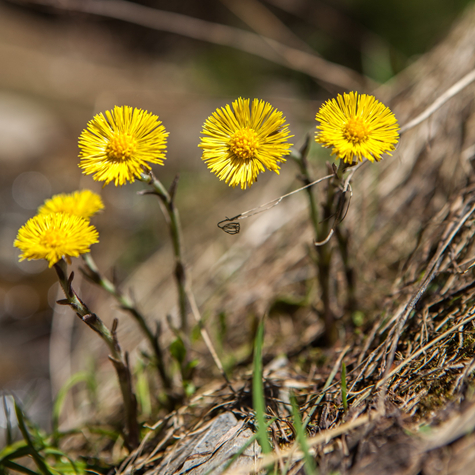
Background
Despite serious safety concerns, coltsfoot is used for asthma, cough, sore throat, swelling of the airways, and other conditions, but there is no good scientific evidence to support these uses.
Safety Safety definitions
When inhaled: There isn't enough reliable information to know if coltsfoot is safe when inhaled or what the side effects might be.
Special Precautions & Warnings:
Coltsfoot is considered LIKELY UNSAFE for anyone, but people with the following conditions should be especially careful about avoiding this plant:Pregnancy and breast-feeding: Coltsfoot preparations are LIKELY UNSAFE for use during pregnancy or breast-feeding. Coltsfoot contains chemicals called hepatotoxic pyrrolizidine alkaloids (PAs). These chemicals might cause birth defects and liver or lung damage. Even if the product is certified hepatotoxic PA-free, it's best to avoid use.
Allergy to ragweed and related plants: Coltsfoot may cause an allergic reaction in people who are allergic to the Asteraceae/Compositae plant family. Members of this family include ragweed, chrysanthemums, marigolds, daisies, and many others. If you have allergies, be sure to check with your healthcare provider before taking coltsfoot.
High blood pressure, heart disease: There is a concern that coltsfoot taken in large amounts might interfere with treatment for these conditions. Don't use coltsfoot if you have these conditions.
Liver disease: There is a concern that hepatotoxic PAs might make liver disease worse. Don't use coltsfoot if you have this condition.
Effectiveness
- Swelling (inflammation) of the main airways in the lung (bronchitis).
- Asthma.
- Swelling (inflammation) of the voice box (laryngitis).
- Whooping cough (pertussis).
- Sore throat.
- Cough.
- Wheezing.
- Other conditions.
Dosing & administration
Interactions with pharmaceuticals
Medications for high blood pressure (Antihypertensive drugs)
Interaction Rating=Moderate Be cautious with this combination.
Excessive doses of coltsfoot seem to increase blood pressure. By increasing blood pressure coltsfoot might decrease the effectiveness of medications for high blood pressure.
Some medications for high blood pressure include captopril (Capoten), enalapril (Vasotec), losartan (Cozaar), valsartan (Diovan), diltiazem (Cardizem), amlodipine (Norvasc), hydrochlorothiazide (HydroDiuril), furosemide (Lasix), and many others.
Medications that increase break down of other medications by the liver (Cytochrome P450 3A4 (CYP3A4) inducers)
Interaction Rating=Moderate Be cautious with this combination.
Coltsfoot is broken down by the liver. Some chemicals that form when the liver breaks down coltsfoot can be harmful. Medications that cause the liver to break down coltsfoot might increase the toxic effects of chemicals contained in coltsfoot.
Some of these medicines include carbamazepine (Tegretol), phenobarbital, phenytoin (Dilantin), rifampin, rifabutin (Mycobutin), and others.
Medications that slow blood clotting (Anticoagulant / Antiplatelet drugs)
Interaction Rating=Moderate Be cautious with this combination.
Coltsfoot might slow blood clotting. Taking coltsfoot along with medications that also slow clotting might increase the chances of bruising and bleeding.
Some medications that slow blood clotting include aspirin, clopidogrel (Plavix), diclofenac (Voltaren, Cataflam, others), ibuprofen (Advil, Motrin, others), naproxen (Anaprox, Naprosyn, others), dalteparin (Fragmin), enoxaparin (Lovenox), heparin, warfarin (Coumadin), and others.
Interactions with herbs & supplements
Herbs and supplements that might slow blood clotting: Coltsfoot might slow blood clotting. Taking it along with other natural products that also slow clotting might increase the chances of bruising and bleeding. Some of these products include angelica, clove, danshen, garlic, ginger, ginkgo, Panax ginseng, and others. Avoid this combination.
Herbs that increase the breakdown of other herbs by the liver: Coltsfoot is broken down by the liver. Some chemicals that form when the liver breaks down coltsfoot can be harmful. Other herbs that cause the liver to break down coltsfoot might increase the toxic effects of the chemicals contained in coltsfoot. Some of these herbs are echinacea, garlic, licorice, St. John's wort, and schisandra. Avoid this combination.
Pyrrolizidine alkaloids (PAs)-containing herbs and supplements: Coltsfoot contains PAs, dangerous chemicals that can harm the liver. Using it along with other herbs that also contain these dangerous chemicals might increase the chance of developing serious side effects, including liver damage and cancer. Other herbs that contain hepatotoxic PAs include alkanna, boneset, borage, butterbur, comfrey, forget-me-not, gravel root, hemp agrimony, hound's tongue, dusty miller, groundsel, golden ragwort and tansy ragwort. Avoid this combination.


